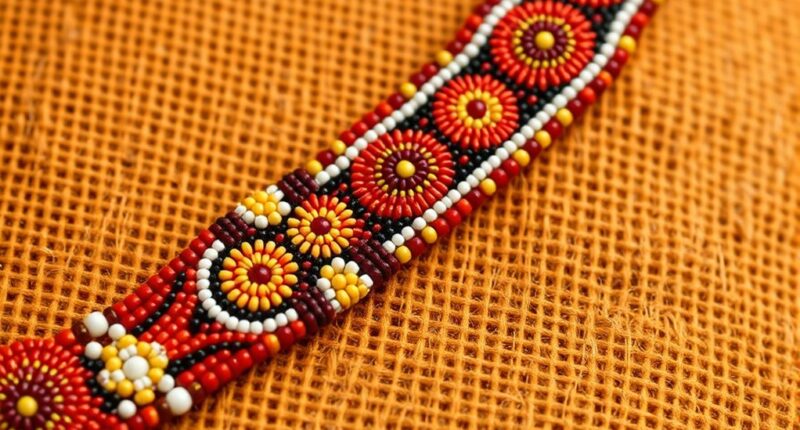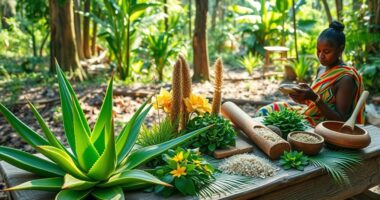Discover that Aboriginal beadwork and jewelry are vibrant ways to express cultural identity, stories, and traditions. You’ll see how skilled artisans use tiny beads and time-honored techniques to create patterns that symbolize Dreamtime stories, kinship, and elements like water or land. Each piece reflects deep craftsmanship, community bonds, and cultural pride. Continue exploring, and you’ll gain a richer understanding of how these adornments preserve heritage and embody resilience across generations.
Key Takeaways
- Aboriginal beadwork and jewelry serve as vibrant expressions of cultural identity, storytelling, and tradition through meaningful patterns and colors.
- Techniques such as bead weaving and embroidery are used to create intricate designs that convey spiritual and kinship stories.
- Materials like glass and shell beads are carefully selected, with craftsmanship reflecting respect for cultural symbolism and mastery.
- Community involvement in beadwork reinforces social bonds, preserves cultural stories, and maintains traditions across generations.
- These handcrafted adornments symbolize resilience, cultural continuity, and serve as living expressions of Aboriginal heritage.

Have you ever wondered how Aboriginal beadwork and jewelry tell stories and preserve cultural heritage? These intricate creations are more than just decorations; they are vibrant expressions of identity, history, and tradition. When you examine these pieces, you’ll notice how cultural symbolism plays a crucial role, with each pattern and color conveying specific meanings rooted in Aboriginal beliefs, stories, and social structures. For example, certain colors might symbolize water, land, or spiritual beings, while specific patterns can represent Dreamtime stories or kinship ties. These symbols serve as a visual language, allowing communities to pass down their stories and values across generations.
As you explore Aboriginal beadwork, you’ll also see the incredible artistic techniques used to craft these items. Artisans employ a variety of methods, from bead weaving to embroidery, each requiring skill and patience. Beadwork, in particular, involves threading tiny glass or shell beads onto fabric or other surfaces, creating detailed patterns that often hold symbolic significance. The precision involved in these techniques reflects a deep respect for tradition and a mastery passed down through countless generations. The choice of materials, the arrangement of beads, and the craftsmanship all contribute to the piece’s cultural meaning, transforming simple adornments into storytelling tools.
Furthermore, the process of creating Aboriginal jewelry is often a communal activity, emphasizing the importance of shared knowledge and cultural continuity. You might find that certain designs are specific to a particular community or family, reinforcing social bonds and identities. The artistic techniques are not only about aesthetics but also about preserving these connections and stories. When you wear or gift Aboriginal jewelry, you carry a piece of this cultural legacy, making it a powerful symbol of identity and history.
In essence, Aboriginal beadwork and jewelry are living expressions of cultural symbolism and artistic mastery. They serve as visual stories that connect past and present, allowing communities to maintain their traditions in a modern world. By understanding the symbolism embedded within these crafts and appreciating the techniques involved, you gain a deeper respect for their cultural significance. These objects are more than beautiful adornments; they are a testament to resilience, storytelling, and the enduring spirit of Aboriginal cultures.
Frequently Asked Questions
How Do Different Aboriginal Groups Distinguish Their Beadwork Styles?
You can tell different Aboriginal groups apart by their beadwork styles, which reflect regional variations and cultural significance. Each group uses unique patterns, colors, and techniques that tell stories or symbolize important traditions. You’ll notice these distinctions in the way they arrange beads, the motifs they choose, and the materials they use. This diversity helps preserve their cultural identity and communicates their history through intricate, meaningful designs.
What Materials Are Traditionally Used in Aboriginal Beadwork?
Imagine holding history in your hands—you’ll find that traditional Aboriginal beadwork uses natural pigments for vibrant dyes and shell ornaments for intricate embellishments. These materials connect you to the land and sea, reflecting cultural stories and spiritual beliefs. Shells from coastal waters are often shaped into beads or pendants, while natural pigments like ochre bring color to the designs. This harmony of materials preserves a timeless craft passed through generations.
How Has Modern Technology Influenced Traditional Beadwork Techniques?
Modern technology has profoundly influenced traditional beadwork techniques by enabling you to access digital design tools, which help create intricate patterns more easily. You can now explore online marketplaces to showcase and sell your work, reaching a broader audience. These advancements empower you to blend traditional skills with contemporary methods, ensuring the preservation and evolution of your craft while making it more accessible and commercially viable in today’s digital age.
Are There Specific Symbols or Patterns Unique to Certain Tribes?
You’ll find that each tribe has its own set of symbolic motifs and pattern variations, like a fingerprint that sets them apart. These unique designs often represent stories, ancestors, or natural elements specific to their culture. While some patterns are shared, many are exclusive, reflecting their distinct histories. Recognizing these symbols helps you appreciate the rich diversity and deep meaning behind each tribe’s beadwork, making every piece a story in itself.
How Do Aboriginal Communities Pass Down Beadwork Knowledge?
You learn beadwork through oral storytelling and community workshops, where elders pass down techniques and cultural meanings. These traditions are often shared in informal settings, allowing you to ask questions and practice alongside others. By participating actively, you absorb the symbols, patterns, and stories that give each piece its cultural significance. This hands-on approach guarantees the knowledge stays alive, connecting you to your community and heritage.
Conclusion
As you explore Aboriginal beadwork and jewellery, remember you’re holding a vibrant thread connecting past and present. Every bead and pattern is like a piece of the community’s heartbeat, weaving stories and traditions into your hands. By appreciating this art, you become part of a living tapestry, where culture flows like a mighty river, shaping identity and heritage. Embrace these crafts, and let their timeless beauty inspire your own journey through history.
Mary is a passionate writer who brings creativity and a fresh perspective to our team. Her words have the power to captivate and inspire, making her an essential contributor to our content. Mary’s commitment to storytelling and dedication to promoting Indigenous culture ensures that her work touches the hearts of our readers. We’re fortunate to have her as part of our team.










